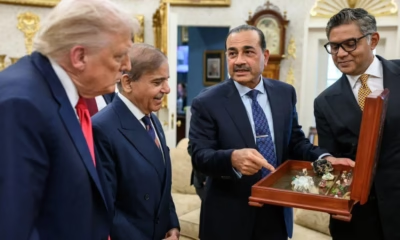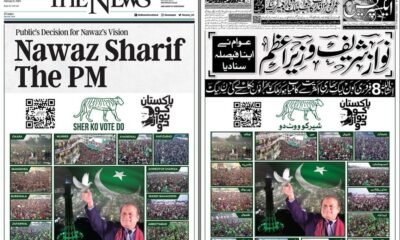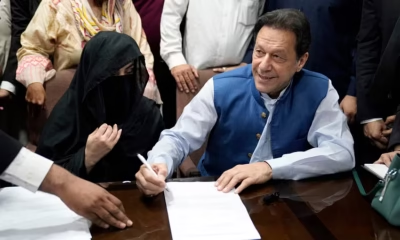Pakistan
Pakistan Elections 2024: Rigging vs Resistance, Mafia vs Mandate
Pakistan elections 2024 were marred by irregularities, but the massive voter turnout swamped the efforts of rigging. This article will cover the many cases of rigging, which we will keep updating as more cases come to light.
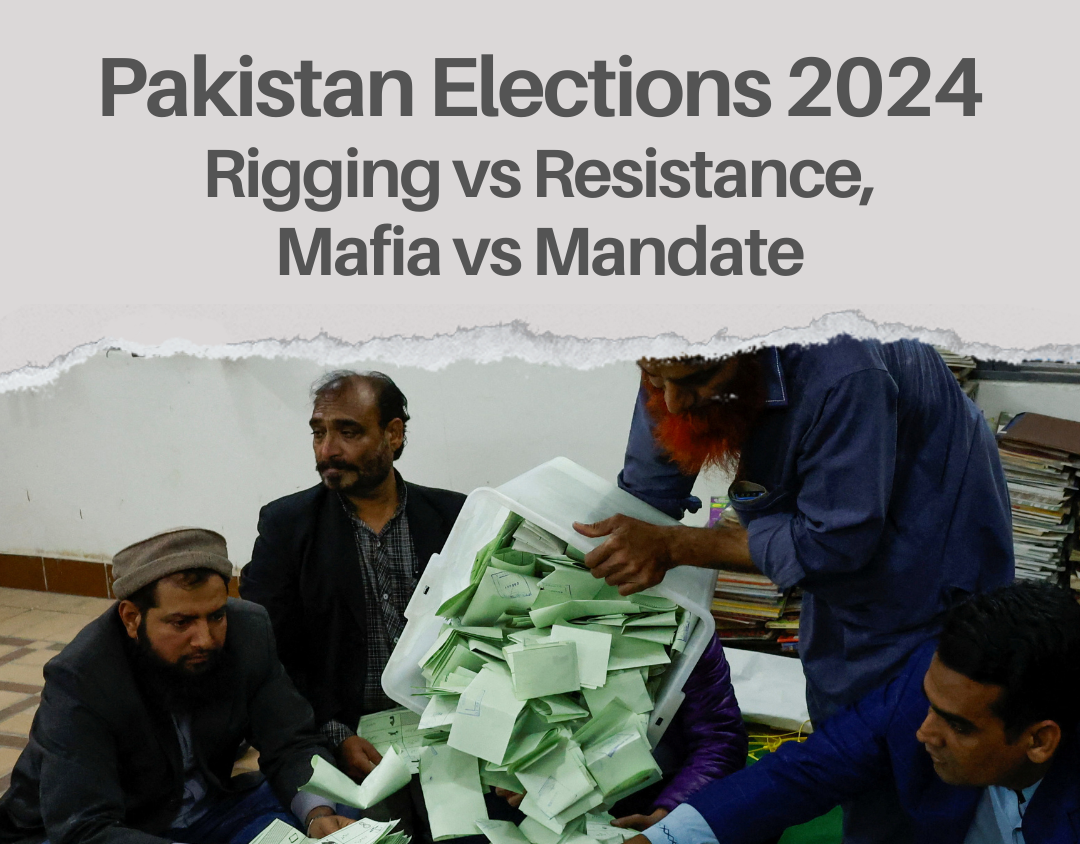
Pakistan General Elections 2024 were neither free nor fair. The entire election process was marred by irregularities and injustice, and the attempts to push the largest political party, Pakistan Tehreek-e-Insaf (PTI), out of contention were blatantly executed. The party’s chairman, former prime minister, Imran Khan, was disqualified and jailed over bogus charges. The party faced a state-backed crackdown, including abductions and “forced divorces.” Leaders and workers were either jailed or forced to go underground. The party’s workers were picked up and tortured, and its electoral symbol was denied through a contentious verdict, forcing the party’s backed candidates to run as independents with individual symbols. Moreover, multiple electoral nominees backed by PTI saw their candidatures rejected by the Election Commission of Pakistan, and those who were able to participate were not allowed to campaign.
This is the background in which Pakistan Elections 2024 took place, and yet, this was not all that was done to jeoperdize the electoral process. Other tactics to subvert the process and the will of the people were employed on election day:
- Internet and mobile phone services were shut down across the country
- Various polling stations did not open on time
- Polling agents of specific political parties were not allowed inside some polling stations
- The polling process was slowed down deliberately, with long queues observed near the end-time
- Election results were withheld and delayed
- RO offices where tabulation was underway sealed by police and rangers, and the candidates not allowed in
- Major discrepancies in results between Forms 45 (the tally of votes from all polling stations) and Form 47 (the consolidated result, formed by adding up the counts from Form 45)
Despite everything done to make Pakistan Elections 2024 controversial and ineffective, Imran Khan and PTI-backed independent candidates defied the odds and thrived in the elections. In the turbulent 24 hours following Pakistan’s elections, the U.S.-backed military was unable to suppress PTI, and the massive turnout swamped the military’s efforts to rig the elections.
Results from polling stations indicated a landslide victory for PTI-backed candidates, with Nawaz Sharif’s politics, even in its former stronghold of Punjab, facing decimation. The people of Pakistan entrusted a 2/3rd majority to Imran Khan in the National assembly, Punjab assembly, and KP assembly, along with landslide victories in Islamabad and Karachi, as confirmed by Form 45s.
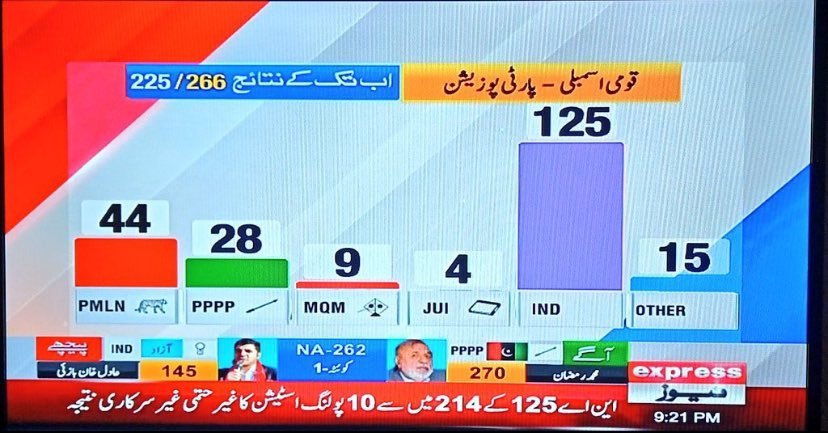
Unfortunately, even though the public’s decision was quite evident, the military decided to intervene and manipulate the election results. Ongoing efforts involve threatening and forcing the Returning Officers (RO) nationwide to declare incorrect results.
These actions are so glaring that they have garnered significant attention, making it increasingly challenging for the military to sustain such practices. Grave concerns have been raised by international media and state departments about stifling the democratic voice of the people of Pakistan, and it appears that the military will inevitably have to yield the power to its true custodians – the people of Pakistan.
Background
The regime change operation
On March 8, 2022, opposition parties under the banner of the Pakistan Democratic Movement (PDM) submitted a no-confidence motion against Prime Minister Imran Khan. On March 27, 2022, Khan publicly waved a diplomatic cypher from the United States, alleging that it called for the removal of his government through a coup. In August 2023, The Intercept published the contents of the diplomatic cable, revealing that American diplomat Donald Lu had stated, “all will be forgiven” regarding Pakistan’s neutrality in the Ukraine conflict if the no-confidence motion against Khan succeeded.
Imran Khan asserted that the United States was behind his removal because of his independent foreign policy and friendly relations with China and Russia. After the 2024 general elections, JUI-F President Fazal-ur-Rehman, a critic of Khan, confirmed that the no-confidence motion was introduced under the instructions of former army chief General Qamar Javed Bajwa.
On April 10, a no-confidence vote was held, resulting in Prime Minister Imran Khan’s ouster, making him the first prime minister in Pakistan to be removed by such a vote. This event triggered widespread protests from his supporters across the country.
The PDM government: the incoming coalition government
After passing the no-confidence motion, on April 11, 2022, the incoming coalition government elected Shehbaz Sharif the Prime Minister of Pakistan, who managed 174 votes out of a total of 342. He was supported by the Pakistan People’s Party (PPP), Muttahida Qaumi Movement (MQM), Jamiat Ulema-e-Islam, and various smaller parties within the Pakistan Democratic Movement (PDM) coalition. Some dissident members of the Pakistan Tehreek-e-Insaf (PTI) also backed his candidacy. Meanwhile, the remaining PTI members, now in opposition, boycotted the session, labeling it as the continuation of a “foreign conspiracy” and branding the new administration as an “imported government.” The following day, over 100 PTI members resigned from their National Assembly seats.
The PDM government remained in power until August 10, 2023. Sharif’s tenure was characterized by severe human rights violations, the erosion of constitutional norms and grave economic challenges, including historically high inflation, a contracting national economy, and a record devaluation of the Pakistani rupee.
Assassination attempt on Imran Khan and his subsequent arrest
After being ousted from government, PTI continued to enjoy widespread popularity, with its supporters frequently taking to the streets across the country. In July 2022, during a provincial by-election in Punjab, PTI won a landslide victory, winning 15 out of 20 seats. In the National Assembly by-elections held in October 2022, PTI won 7 out of 9 seats, with Khan personally winning 6 of the 7 seats he contested. Later that month, Imran Khan led a large and well-attended long march through Punjab, demanding early general elections.
However, on November 3, 2022, while leading the march through Wazirabad, Imran Khan was shot and injured in an assassination attempt.
As Khan recovered from the gunshot wounds to his leg, the government filed multiple cases against him and attempted to arrest him from his residence in Zaman Park on two separate occasions in March 2023. Both times, the police were unable to detain him due to the intervention of his supporters. On May 9, 2023, Khan was violently arrested by paramilitary forces at the Islamabad High Court, a day after the army warned him for accusing Major General Faisal Naseer of the ISI of being involved in the November 2022 assassination attempt. The arrest sparked nationwide unrest, leading to the May 9 riots, where some protesters targeted military installations.
In response, the military establishment launched a brutal crackdown on the PTI. PTI party leaders, workers, supporters, and those perceived as sympathetic to the party within the media and legal profession were targeted. Trials of civilians within military courts were also initiated. Several core leaders of the party have been in hiding since, with many incarcerated or forced to abandon the party. Subsequently, two pro-establishment splinter groups emerged from within the PTI, namely the PTI Parliamentarians (PTI-P), led by Pervez Khattak, and the Istehkam-e-Pakistan Party (IPP), led by Jahangir Tareen.
Constitutional erosion
In January 2023, in an effort to force early general elections, PTI dissolved the assemblies where it held power—the Punjab assembly and the Khyber-Pakhtunkhwa assembly. According to the Constitution of Pakistan, once an assembly is dissolved, elections must be held within 90 days, setting a constitutional deadline for the two provincial elections no later than April 2023.
However, the Election Commission of Pakistan (ECP) postponed the provincial assemblies’ elections until October 2023, citing a lack of funds from the PDM government and the unavailability of required security personnel. PTI challenged the ECP’s decision in the Supreme Court of Pakistan, arguing that it violated the constitution. The Supreme Court, in a majority verdict, declared the ECP’s decision unconstitutional and ordered that provincial assemblies’ elections be held by May 14, 2023.
Despite this ruling, the election deadline passed without the Supreme Court’s order being enforced, following the nationwide May 9 riots that erupted after Imran Khan’s arrest. On August 10, 2023, President Arif Alvi, on the advice of Prime Minister Shehbaz Sharif, dissolved the National Assembly, mandating that general elections be held no later than November 8, 2023.
However, on August 5, 2023, the results of the 2023 digital census were approved by the Council of Common Interests, led by Shehbaz Sharif. This approval prompted the ECP to delay elections until February 2024 at the latest, in order to carry out fresh electoral delimitations based on the new census data.
Despite this, on September 13, 2023, President Alvi proposed November 6, 2023, as a potential election date to the ECP and advised them to seek guidance from the Supreme Court regarding the announcement of the election date. On November 2, 2023, the ECP and the President agreed on February 8, 2024, as the date for the general election.
Return of Nawaz Sharif to electoral politics
In May 2023, the PDM government enacted a law allowing for the filing of review petitions against previous Supreme Court verdicts. In June 2023, another law was passed, limiting disqualification to five years and allowing the Election Commission to announce election dates without consulting the President of the country.
After serving only a few months of his 7-year sentence on corruption charges, former Prime Minister Nawaz Sharif left Pakistan on November 19, 2019, to receive medical treatment in London, promising to return within four weeks. However, he did not return, and in 2021, he was declared a fugitive after failing to appear before the courts despite multiple summonses.
As part of what has been termed the “London Plan,” Sharif secured protective bail on October 19, 2023, allowing him to return to Pakistan after four years of self-imposed exile without being arrested. He returned to the country on October 21, 2023.
On January 9, 2024, a seven-member Supreme Court bench led by Chief Justice Qazi Faez Isa, while hearing a review petition against lifetime disqualification, delivered a 6–1 majority verdict, with Justice Yahya Afridi dissenting. The court overturned the previous interpretation of lifetime disqualification under Article 62(1)(f) of the constitution, stating that it violated fundamental rights. Instead, the court set a five-year disqualification period for lawmakers who fail to meet the moral standard of “sadiq and ameen” (honest and righteous), in line with the newly enacted laws. This verdict has made Sharif, who was disqualified for life in the 2017 Panama Papers case, eligible to contest the upcoming elections.
PTI de facto ban through intra-party election verdict
On December 22, 2023, the Election Commission of Pakistan (ECP) decided to revoke PTI’s electoral symbol, citing the party’s failure to conduct intra-party elections to the commission’s satisfaction. In response, PTI immediately appealed to the Peshawar High Court (PHC) on the same day, challenging the ECP’s decision. A single-member bench of the PHC suspended the ECP’s order until January 9, 2024. However, on December 30, 2023, the ECP submitted a review application to the PHC. In the following days, a two-member bench lifted the suspension order during the ongoing hearing. Nevertheless, on January 10, 2024, the two-member bench ruled that the ECP’s order was “illegal, without any lawful authority, and of no legal effect.” The following day, January 11, the ECP challenged this ruling in the Supreme Court.
On January 13, just weeks before the general elections, a three-member panel of the Supreme Court, led by Chief Justice Qazi Faez Isa, sided with the ECP, reinstating their decision to deny PTI its election symbol, the cricket bat, due to the party’s failure to conduct intra-party elections as required by its constitution. As a result, PTI was unable to allocate party tickets to its candidates, forcing all party candidates to run as independents with individual electoral symbols.
Revoking the cricket bat symbol of Pakistan’s largest party was viewed as preventing voters from recognizing the party on ballot papers—a crucial factor in Pakistan where 40% of the population is illiterate.
The Supreme Court’s decision led some legal experts to describe the ruling as a “huge blow to fundamental rights” and “a defeat for democratic norms.
Imran Khan’s convictions
In the week leading up to the elections, Former Prime Minister Imran Khan was sentenced to prison terms in three separate cases. On January 30, 2024, with the government seeking the death penalty, Imran Khan was sentenced to 10 years in prison for mishandling state secrets by Judge Abul Hasnat Zulqarnain.
The following day, Judge Muhammad Bashir sentenced him and his wife, Bushra Bibi, to 14 years in prison each, along with a fine in the Toshakhana case. This ruling also barred Khan from holding public office for 10 years.
Two days later, Judge Qudratullah declared the marriage of Khan and Bushra Bibi unlawful under Islamic law, sentencing both to seven years in prison for allegedly solemnizing their marriage during Bushra’s Iddah period. This case was filed five years after their marriage by Khawar Maneka, Bushra’s former husband.
All three trials were held behind closed doors at Adiala Jail, where Khan had been incarcerated since August 2023 on corruption charges. The trials were marked by rushed proceedings, the sudden replacement of Khan’s defence lawyers with state-appointed counsel, and other procedural irregularities, leading his party to denounce the verdicts as the product of “kangaroo courts.”
Khan’s conviction in the marriage case was widely criticized by lawyers and civil society members as an overreach and a blow to women’s rights. Meanwhile, some observers viewed these sentences as part of the Pakistani military’s efforts to keep Khan out of power in the upcoming elections.
Pre-poll rigging
Observers, including the United Nations and Human Rights Watch, have raised concerns about apparent pre-poll rigging in the lead-up to the upcoming elections. There have been notable actions against the PTI and its leaders, including snatching of nomination papers, arbitrary arrests of candidates and their supporters, systematic rejection of nomination papers, and disruption of campaign events. These incidents suggest “election engineering” and manipulative practices that could potentially favour certain political groups, casting doubt on the fairness of the electoral process.
Pakistan’s Electoral Commission was also accused of gerrymandering in favour of the Pakistan Muslim League-Nawaz during the redrawing of voter maps before the elections, with a record 1,300 complaints being filed.
Following the ban on the use of the cricket bat as the PTI’s party symbol, many PTI-affiliated candidates were assigned symbols with obscure meanings and awkward connotations, such as a calculator, an electric heater, dice, a bed, an eggplant—considered anatomically suggestive—and a bottle, which implies alcohol consumption in a majority Muslim country.
Numerous PTI candidates were reportedly beaten and imprisoned, while others were compelled to join opposing parties or quit politics entirely. A strict order was issued to prohibit mentioning Khan’s name on television, and PTI protests were suppressed, with supporters being harassed and arrested by the military, judiciary, and other political parties. The majority of the PTI leadership found themselves either imprisoned or in exile, and PTI rallies were targeted by attacks and bombings, making campaigning virtually impossible as candidates were forced into hiding.
The Intercept reported allegations of military involvement in the torture and killing of PTI supporters and also noted that Pakistani media has been significantly restricted over the past year, making critical reporting on the army and government nearly impossible.
In one notable instance, Usman Dar, a former member of Imran Khan’s cabinet, announced his resignation from the PTI and withdrew from the election after being abducted. His mother, Rehana Dar, subsequently appeared on television, declaring her intention to contest against Khawaja Asif. She stated, “You have achieved what you wanted by making my son [Usman Dar] step down at gunpoint, but my son has quit politics, not me. Now you will face me in politics.
Just 48 hours before voting, a full-page advertisement declaring Nawaz Sharif as the prime minister was published on the front pages of every newspaper in the country.
Censorship
On January 26, 2024, PTI’s official website, insaf.pk, and a separate website made for disseminating information regarding the individual electoral symbols of the party’s candidates were blocked in Pakistan. Additionally, a voter helpline set up by the party was also blocked. Earlier, social media platforms had been blocked during the party’s virtual electoral events on at least three separate occasions, as reported by the internet watchdog NetBlocks.
Journalists covering the elections reported a near-total restriction on their ability to cover PTI candidates impartially. News channels allegedly received instructions from individuals linked to Pakistan’s military establishment to remove all references to PTI from their visuals, graphics, and talking points.
Pakistan General Elections 2024
This section will collect the cases of election day and post-poll rigging cases from Pakistan General Elections 2024.
Note: throughout the examples, “PTI” refers to a PTI-backed candidate, who had to run as an independent after the SC’s controversial judgment in the Bat case.
On-going analysis of Form-45 and Form-47 of national assembly constituencies where the result has been falsely declared
NA-28: Peshawar
76% result
- PTI: 52,796
- Noor Alam Khan: 32,976
100% result
- PTI: 65,119
- Noor Alam Khan: 138,389

NA-46: Islamabad
Result as per Form 45 (100% polling stations)
- PTI-backed candidate: 85,793
- Second-placed candidate: 42,043
- PTI win margin: 43,745
Result consolidated by ECP on Form 47
- PTI-backed candidate: 44,317
- Second-placed candidate: 81,958
NA-47: Islamabad
Result as per Form 45 (100% polling stations)
- PTI-backed candidate: 101,596
- Second-placed candidate: 49,678
- PTI win margin: 51,918
Result consolidated by ECP on Form 47
- PTI-backed candidate: 86,794
- Second-placed candidate: 101,397
NA-48: Islamabad
Result as per Form 45 (98% polling stations)
- PTI-backed candidate: 74,425
- Second-placed candidate: 30,345
- PTI win margin: 44,080
Result consolidated by ECP on Form 47
- PTI-backed candidate: 59,851
- Second-placed candidate: 69,699
NA-49: Attock
Result as per Form 45 (100% polling stations)
- PTI-backed candidate: 137,804
- Second-placed candidate: 74,478
- PTI win margin: 63,326
Result consolidated by ECP on Form 47
- PTI-backed candidate: 110,230
- Second-placed candidate: 119,727
NA-50: Attock
Result as per Form 45 (100% polling stations)
- PTI-backed candidate: 117,571
- Second-placed candidate: 93,815
- PTI win margin: 23,696
Result consolidated by ECP on Form 47
- PTI-backed candidate: 109,189
- Second-placed candidate: 119,075
NA-53: Rawalpindi
Result as per Form 45 (100% polling stations)
- PTI-backed candidate: 79,204
- Second-placed candidate: 45,154
- PTI win margin: 39,050
Result consolidated by ECP on Form 47
- PTI-backed candidate: 58,476
- Second-placed candidate: 72,006
NA-54: Rawalpindi
Result as per Form 45 (92% polling stations)
- PTI-backed candidate: 96,488
- Second-placed candidate: 42,845
- PTI win margin: 53,643
Result consolidated by ECP on Form 47
- PTI-backed candidate: 73,694
- Second-placed candidate: 85,912
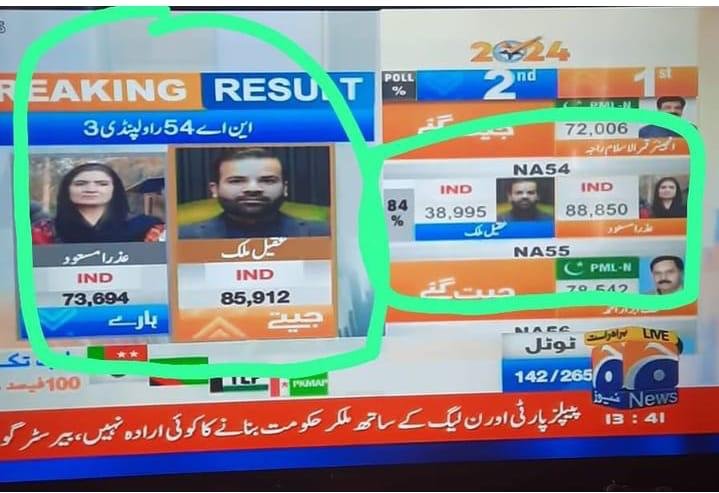
NA-55: Rawalpindi
Result as per Form 45 (74% polling stations)
- PTI-backed candidate: 80,418
- Second-placed candidate: 38,697
- PTI win margin: 41,721
Result consolidated by ECP on Form 47
- PTI-backed candidate: 96,787
- Second-placed candidate: 112,343
NA-56: Rawalpindi
Result as per Form 45 (92% polling stations)
- PTI-backed candidate: 101,525
- Second-placed candidate: 62,708
- PTI win margin: 38,817
Result consolidated by ECP on Form 47
- PTI-backed candidate: 82,613
- Second-placed candidate: 96,649
NA-57: Rawalpindi
Result as per Form 45 (99% polling stations)
- PTI-backed candidate: 101,622
- Second-placed candidate: 50,149
- PTI win margin: 51,473
Result consolidated by ECP on Form 47
- PTI-backed candidate: 56,789
- Second-placed candidate: 83,331
NA-58: Chakwal
Result as per Form 45
- PTI-backed candidate: 155,070
- Second-placed candidate: 129,312
- PTI win margin: 25,758
Result consolidated by ECP on Form 47
- PTI-backed candidate: 102,537
- Second-placed candidate: 115,974
NA-60: Jhelum
Result as per Form 45 (92% polling stations)
- PTI-backed candidate: 105,283
- Second-placed candidate: 62,135
- PTI win margin: 43,148
Result consolidated by ECP on Form 47
- PTI-backed candidate: 90,474
- Second-placed candidate: 99,948
NA-64: Gujrat
Result as per Form 45 (100% polling stations)
- PTI’s Qaisra Elahi: 151,373
- PMLQ’s Salik Hussain: 28,204
- PTI win margin: 123,171
Result consolidated by ECP on Form 47
- PTI candidate’s votes: 90,946
- Opposing candidate’s votes: 105,205
Ballot papers were also burnt, which as per evidence were cast for PTI’s Qaisra Elahi

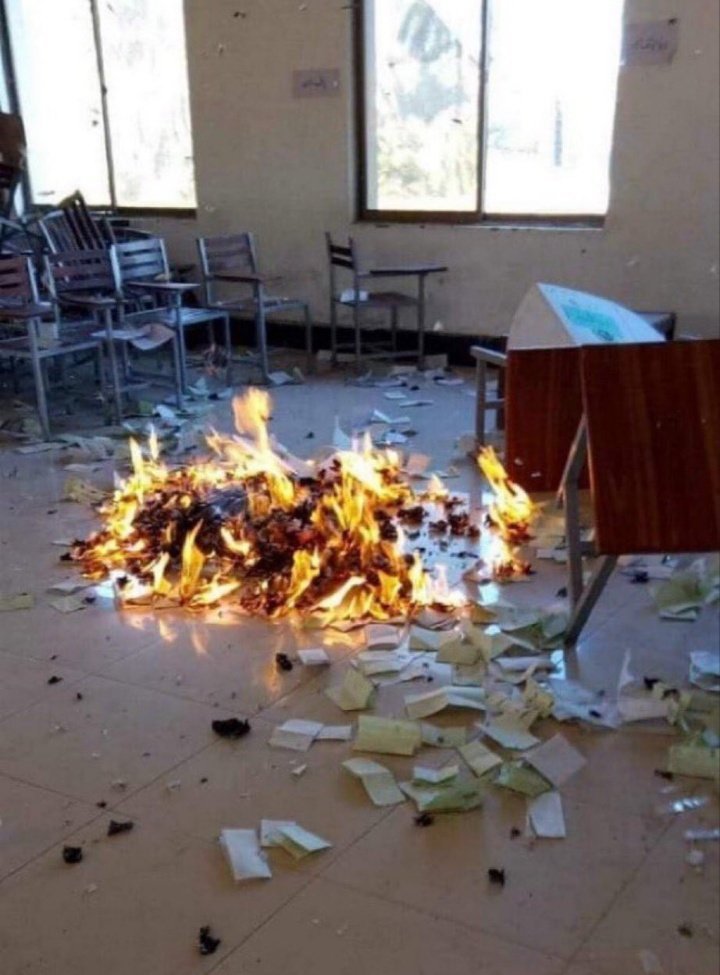
NA-71: Sialkot
Result as per Form 45 (67% polling stations)
- PTI’s Rehana Dar: 88,278
- Opposing candidate: 57,360
- PTI win margin: 30,918
Result consolidated by ECP on Form 47
- PTI-backed candidate: 100,482
- Second-placed candidate: 119,001
NA-87: Khushab
Result as per Form 45 (93% polling stations)
- PTI-backed candidate: 123,759
- Second-placed candidate: 83,376
- PTI win margin: 40,383
Result consolidated by ECP on Form 47
- PTI-backed candidate: 108,308
- Second-placed candidate: 117,773
NA-106: Toba Tek Singh
Result as per Form 45 (100% polling stations)
- PTI-backed candidate: 138,409
- Second-placed candidate: 132,673
- PTI win margin: 5,736
Result consolidated by ECP on Form 47
- PTI-backed candidate: 136,924
- Second-placed candidate: 137,629
NA-126: Lahore
Result as per Form 45 (100% polling stations)
- PTI-backed candidate: 72,782
- Second-placed candidate: 39,608
- PTI win margin: 33,174
Result consolidated by ECP on Form 47
- PTI-backed candidate: 60,479
Second-placed candidate: 67,117
NA-128: Lahore
Result as per Form 45 (91% polling stations)
- PTI-backed candidate: 142,727
- Second-placed candidate: 59,900
- PTI win margin: 82,827
Result consolidated by ECP on Form 47
- PTI-backed candidate: 159,024
- Second-placed candidate: 172,576
NA-130: Lahore
Result as per Form 45 (91% polling stations)
- PTI-backed candidate: 101,933
- Second-placed candidate: 80,895
- PTI win margin: 21,038
Result consolidated by ECP on Form 47
- PTI-backed candidate: 104,485
- Second-placed candidate: 179,310
NA-139: Pakpattan
Result as per Form 45
- PTI-backed candidate: 126,743
- Second-placed candidate: 112,140
- PTI win margin: 14,603
Result consolidated by ECP on Form 47
- PTI-backed candidate: 116,493
- Second-placed candidate: 121,383
NA-148: Multan
Result as per Form 45 (100% polling stations)
- PTI-backed candidate: 75,422
- Second-placed candidate: 68,956
- PTI win margin: 6,466
Result consolidated by ECP on Form 47
- PTI-backed candidate: 67,033
- Second-placed candidate: 67,326
NA-151: Multan
Result as per Form 45 (100% polling stations)
- PTI-backed candidate: 83,760
- Second-placed candidate: 78,099
- PTI win margin: 5,661
Result consolidated by ECP on Form 47
- PTI-backed candidate: 71,649
- Second-placed candidate: 79,080
NA-163: Bahawalnagar
Result as per Form 45 (99% polling stations)
- PTI-backed candidate: 96,710
- Second-placed candidate: 58,822
- PTI win margin: 37,888
Result consolidated by ECP on Form 47
- PTI-backed candidate: 75,115
- Second-placed candidate: 84,312
NA-164: Bahawalnagar
Result as per Form 45 (99% polling stations)
- PTI-backed candidate: 122,378
- Second-placed candidate: 103,797
- PTI win margin: 18,581
Result consolidated by ECP on Form 47
- PTI-backed candidate: 117,140
- Second-placed candidate: 123,360
NA-168: Bahawalpur
Result as per Form 45 (83% polling stations)
- PTI-backed candidate: 86,248
- Second-placed candidate: 52,249
- PTI win margin: 33,999
Result consolidated by ECP on Form 47
- PTI-backed candidate: 52,270
- Second-placed candidate: 124,529
NA184: DG Khan
PTI candidate’s opponent, Javed Akhtar Lound, accepts that PTI’s Ali Muhammad Khalol has won the seat by a lead of 50,000+ on NA184, and PTI Sardar Farhat Abbas won with a lead of 15,000+ on PP286 but the results have been blatantly manipulated to deprive PTI of this victory.
NA-219: Hyderabad
Result as per Form 45 (82% polling stations)
- PTI-backed candidate: 52,999
- Second-placed candidate: 18,276
- PTI win margin: 34,723
Result consolidated by ECP on Form 47
- PTI-backed candidate: 38,315
- Second-placed candidate: 55,050
NA-220: Hyderabad
Result as per Form 45 (64% polling stations)
- PTI-backed candidate: 34,756
- Second-placed candidate: 24,252
- PTI win margin: 10,504
Result consolidated by ECP on Form 47
- PTI-backed candidate: 52,025
- Second-placed candidate: 64,531
NA-232: Karachi
Result as per Form 45 (96% polling stations)
- PTI-backed candidate: 74,469
- Second-placed candidate: 18,479
- PTI win margin: 55,990
Result consolidated by ECP on Form 47
- PTI-backed candidate: 66,753
- Second-placed candidate: 84,592
NA-233: Karachi
Result as per Form 45 (90% polling stations)
- PTI-backed candidate: 61,801
- Second-placed candidate: 15,779
- PTI win margin: 46,022
Result consolidated by ECP on Form 47
- PTI-backed candidate: 58,753
- Second-placed candidate: 103,967
NA-234: Karachi
Result as per Form 45 (87% polling stations)
- PTI-backed candidate: 55,227
- Second-placed candidate: 9,907
- PTI win margin: 45,320
Result consolidated by ECP on Form 47
- PTI-backed candidate: 43,744
- Second-placed candidate: 73,687
NA-235: Karachi
Result as per Form 45 (99% polling stations)
- PTI-backed candidate: 21,788
- Second-placed candidate: 2,464
- PTI win margin: 19,324
Result consolidated by ECP on Form 47
- PTI-backed candidate: 14,167
- Second-placed candidate: 20,187
NA-236: Karachi
Result as per Form 45 (91% polling stations)
- PTI-backed candidate: 103,639
- Second-placed candidate: 7,481
- PTI win margin: 96,158
Result consolidated by ECP on Form 47
- PTI-backed candidate: 1,154
- Second-placed candidate: 38,871
NA-237: Karachi
Result as per Form 45 (86% polling stations)
- PTI-backed candidate: 43,915
- Second-placed candidate: 21,457
- PTI win margin: 22,458
Result consolidated by ECP on Form 47
- PTI-backed candidate: 33,321
- Second-placed candidate: 40,836
NA-238: Karachi
Result as per Form 45 (90% polling stations)
- PTI-backed candidate: 77,841
- Second-placed candidate: 30,983
- PTI win margin: 46,858
Result consolidated by ECP on Form 47
- PTI-backed candidate: 36,875
- Second-placed candidate: 54,884
NA-239: Karachi
Result as per Form 45 (99% polling stations)
- PTI-backed candidate: 41,066
- Second-placed candidate: 35,252
- PTI win margin: 5,814
Result consolidated by ECP on Form 47
- PTI-backed candidate: 37,234
- Second-placed candidate: 40,077
NA-240: Karachi
Result as per Form 45 (90% polling stations)
- PTI-backed candidate: 42,435
- Second-placed candidate: 10,706
- PTI win margin: 31,729
Result consolidated by ECP on Form 47
- PTI-backed candidate: 27,318
- Second-placed candidate: 30,573
NA-241: Karachi
Result as per Form 45 (94% polling stations)
- PTI-backed candidate: 78,044
- Second-placed candidate: 20,558
- PTI win margin: 57,486
Result consolidated by ECP on Form 47
- PTI-backed candidate: 48,610
- Second-placed candidate: 52,456
NA-242: Karachi
Result as per Form 45 (96% polling stations)
- PTI-backed candidate: 52,957
- Second-placed candidate: 22,932
- PTI win margin: 30,025
Result consolidated by ECP on Form 47
- PTI-backed candidate: 53,759
- Second-placed candidate: 71,767
NA-243: Karachi
Result as per Form 45 (98% polling stations)
- PTI-backed candidate: 50,295
- Second-placed candidate: 46,049
- PTI win margin: 4,246
Result consolidated by ECP on Form 47
- PTI-backed candidate: 48,690
- Second-placed candidate: 60,266
NA-244: Karachi
Result as per Form 45 (98% polling stations)
- PTI-backed candidate: 19,497
- Second-placed candidate: 7,445
- PTI win margin: 12,052
Result consolidated by ECP on Form 47
- PTI-backed candidate: 14,073
- Second-placed candidate: 20,048
NA-245: Karachi
Result as per Form 45 (92% polling stations)
- PTI-backed candidate: 38,519
- Second-placed candidate: 11,522
- PTI win margin: 26,997
Result consolidated by ECP on Form 47
- PTI-backed candidate: 36,788
- Second-placed candidate: 57,356
NA-246: Karachi
Result as per Form 45 (91% polling stations)
- PTI-backed candidate: 52,114
- Second-placed candidate: 28,136
- PTI win margin: 23,978
Result consolidated by ECP on Form 47
- PTI-backed candidate: 29,528
- Second-placed candidate: 74,672
NA-247: Karachi
Result as per Form 45 (93% polling stations)
- PTI-backed candidate: 50,749
- Second-placed candidate: 21,646
- PTI win margin: 29,103
Result consolidated by ECP on Form 47
- PTI-backed candidate: 52,058
- Second-placed candidate: 65,050
NA-248: Karachi
Result as per Form 45 (100% polling stations)
- PTI-backed candidate: 68,444
- Second-placed candidate: 15,271
- PTI win margin: 53,173
Result consolidated by ECP on Form 47
- PTI-backed candidate: 86,342
- Second-placed candidate: 103,082
NA-249: Karachi
Result as per Form 45 (84% polling stations)
- PTI-backed candidate: 53,044
- Second-placed candidate: 21,829
- PTI win margin: 31,215
Result consolidated by ECP on Form 47
- PTI-backed candidate: 51,152
- Second-placed candidate: 77,529
NA-250: Karachi
Result as per Form 45 (100% polling stations)
- PTI-backed candidate: 65,304
- Second-placed candidate: 8,799
- PTI win margin: 56,505
Result consolidated by ECP on Form 47
- PTI-backed candidate: 37,629
- Second-placed candidate: 79,925
Other instances of election rigging, manipulation and irregularities during the Pakistan Elections 2024
Rawalpindi Division
On February 11, 2024, the commissioner of Rawalpindi, who was also appointed as the District Returning Officer for the Rawalpindi division confessed that he helped rig Pakistan’s elections on the 13 National Assembly seats in Rawalpindi division.
“We converted the losers into winners, reversing margins of 70,000 votes in 13 national assembly seats,” he told reporters, also implicating the head of the election commission and the country’s top judge.
The commissioner admitted he was “deeply involved in serious crime like mega election rigging 2024” and said that “stabbing the country in its back” does not allow him to sleep.
“I should be punished for the injustice I have done and others who were involved in this injustice should also be punished,” he added.
NA127: Lahore
PTI candidate Zaheer Khokhar was on the ballot paper but was missing from Form 45 – on which each polling station is results are compiled.
NA-128: Lahore
- Aun Chaudhry and his 3 dozen goons attacked the RO Office. PTI volunteer Sameer Khosa was badly injured. After realising that he is losing by a huge margin, the goons disturb the counting process. Salman Akram Raja was evicted from the RO Office. The ballot boxes and Form 45 were at the mercy of unknown persons. SP Irtiza says he doesn’t believe in any law and evicted the PTI candidate during the counting process. Meanwhile, the police allowed the goons to enter the RO Office and beat everyone.
- Instead of arresting these goons and their leader, the police deprived the PTI candidate of his legal right to be present during the consolidation process.
NA 130: Lahore
More valid votes than total votes cast
Total votes cast: 293,693
Valid votes counted: 294,043
NA-158: Vehari
The RO swapped the name of PTI’s candidate with PMLN’s candidate to make the PMLN candidate win
NA-242: Karachi
Qadir Khan Mandokhail, Pakistan People’s Party’s candidate for the NA-242 constituency of Karachi barged into a polling station with his gang
PS110: Karachi
Jibran Nasir, candidate PS110, and PTI’s opponent on the seat, shares that as per Form 45 received so far from 42 polling stations out of a total of 159 stations, PTI was leading, JI was second and he was third. However, the results of the remaining polling stations were being delayed & denied, using tactics such as not counting or Polling Staff making ridiculous excuses that they didn’t have a hard copy of Form 45 to fill and give to polling agents.
Peshawar
In Peshawar in Qayyum Stadium where ROs for NA-31 and NA-33 are sitting Elections Agents or Candidates are not allowed to enter.
Lodhran
DPO Lodhran is pushing and punching the PTI agent out.

